sensor KIA QUORIS 2016 User Guide
[x] Cancel search | Manufacturer: KIA, Model Year: 2016, Model line: QUORIS, Model: KIA QUORIS 2016Pages: 513, PDF Size: 30.14 MB
Page 83 of 513
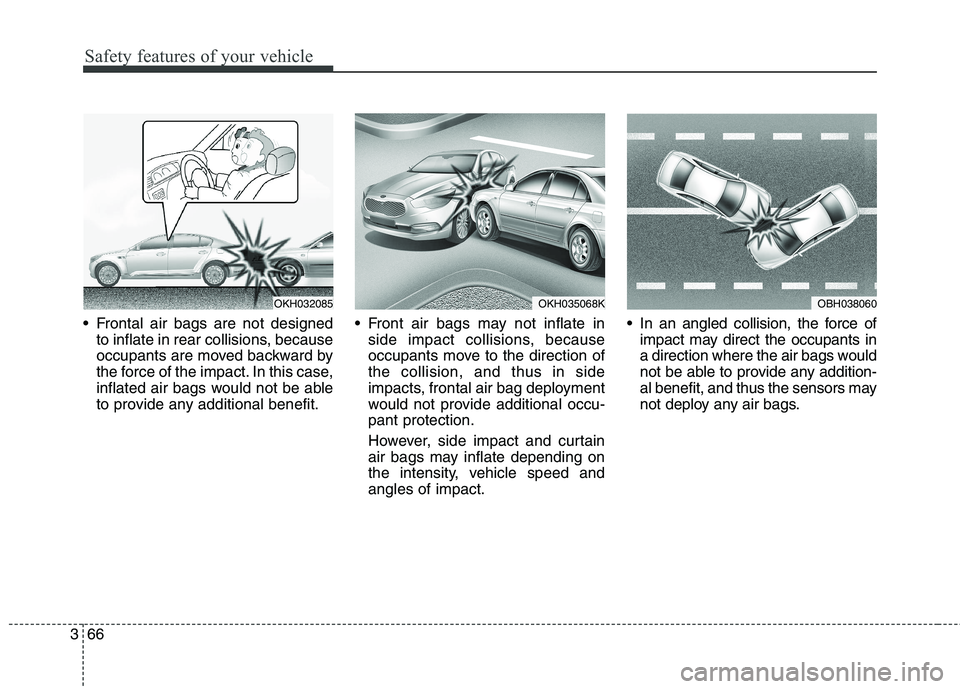
Safety features of your vehicle
66
3
Frontal air bags are not designed
to inflate in rear collisions, because
occupants are moved backward by
the force of the impact. In this case,
inflated air bags would not be able
to provide any additional benefit. Front air bags may not inflate in
side impact collisions, because
occupants move to the direction ofthe collision, and thus in side
impacts, frontal air bag deployment
would not provide additional occu-pant protection.
However, side impact and curtain
air bags may inflate depending on
the intensity, vehicle speed andangles of impact. In an angled collision, the force of
impact may direct the occupants in
a direction where the air bags would
not be able to provide any addition-
al benefit, and thus the sensors may
not deploy any air bags.
OBH038060OKH035068KOKH032085
Page 84 of 513
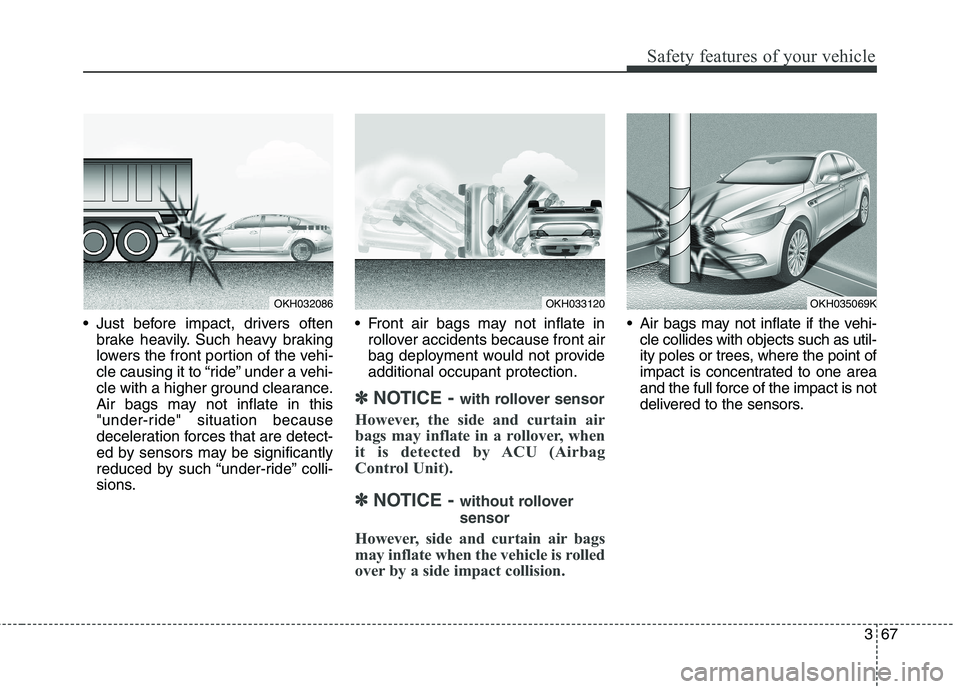
367
Safety features of your vehicle
Just before impact, drivers oftenbrake heavily. Such heavy braking
lowers the front portion of the vehi-
cle causing it to “ride” under a vehi-
cle with a higher ground clearance.
Air bags may not inflate in this
"under-ride" situation because
deceleration forces that are detect-
ed by sensors may be significantly
reduced by such “under-ride” colli-
sions. Front air bags may not inflate in
rollover accidents because front air
bag deployment would not provideadditional occupant protection.
✽✽ NOTICE - with rollover sensor
However, the side and curtain air
bags may inflate in a rollover, when
it is detected by ACU (Airbag
Control Unit).
✽
✽ NOTICE - without rollover sensor
However, side and curtain air bags
may inflate when the vehicle is rolled
over by a side impact collision.
Air bags may not inflate if the vehi- cle collides with objects such as util-
ity poles or trees, where the point of
impact is concentrated to one area
and the full force of the impact is not
delivered to the sensors.
OKH032086OKH033120OKH035069K
Page 136 of 513

449
Features of your vehicle
Inside rearview mirror
Adjust the rearview mirror to center
on the view through the rear window.
Make this adjustment before you
start driving.Electric chromic mirror (ECM)
The electric chromic mirror automati- cally controls the glare from the head-
lights of the car behind you in night-
time or low light driving conditions. Thesensor mounted in the mirror senses
the light level around the vehicle, andautomatically controls the headlight
glare from vehicles behind you.
When the engine is running, the
glare is automatically controlled by
the sensor mounted in the rearview
mirror.Whenever the shift lever is shifted
into R (Reverse), the mirror will auto-
matically go to the brightest setting in
order to improve the drivers view
behind the vehicle.
MIRRORS
CAUTION
When cleaning the mirror, use a
paper towel or similar materialdampened with glass cleaner. Do not spray glass cleanerdirectly on the mirror as thatmay cause the liquid cleaner toenter the mirror housing.WARNING - Rear visibility
Do not place objects in the rear
seat or cargo area which would
interfere with your vision
through the rear window.
WARNING
Do not modify the inside mirror
and don’t install a wide mirror. It
could result in injury, during an
accident or deployment of the
air bag.
OKH042291L
Sensor
Page 138 of 513
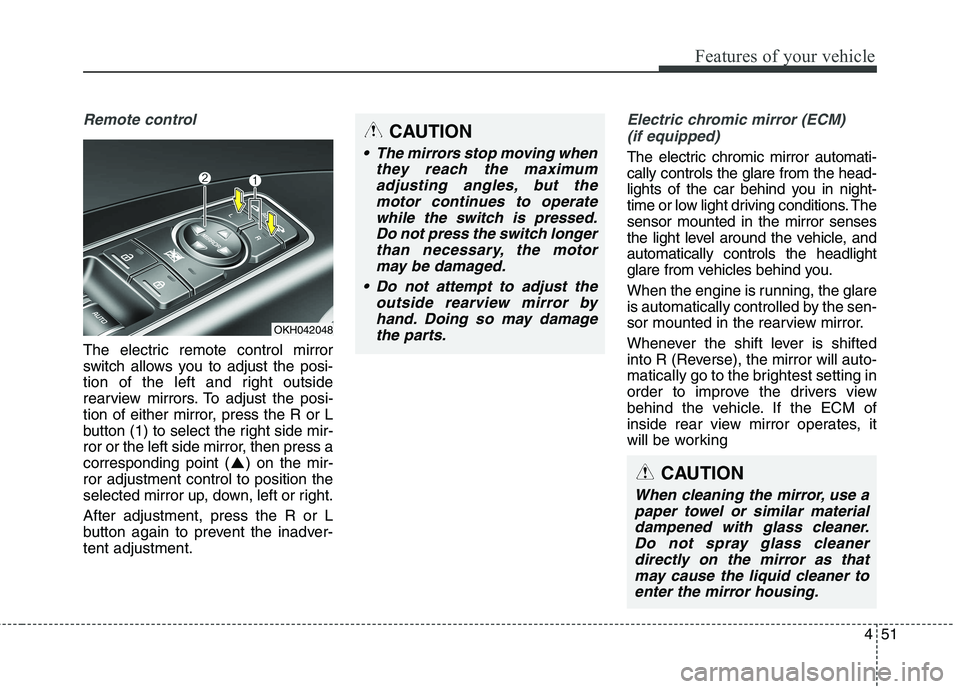
451
Features of your vehicle
Remote control
The electric remote control mirror
switch allows you to adjust the posi-
tion of the left and right outside
rearview mirrors. To adjust the posi-
tion of either mirror, press the R or L
button (1) to select the right side mir-
ror or the left side mirror, then press a
corresponding point ( ) on the mir-ror adjustment control to position the
selected mirror up, down, left or right. After adjustment, press the R or L
button again to prevent the inadver-tent adjustment.
Electric chromic mirror (ECM) (if equipped)
The electric chromic mirror automati- cally controls the glare from the head-
lights of the car behind you in night-
time or low light driving conditions. Thesensor mounted in the mirror senses
the light level around the vehicle, andautomatically controls the headlight
glare from vehicles behind you.
When the engine is running, the glare
is automatically controlled by the sen-
sor mounted in the rearview mirror.
Whenever the shift lever is shifted
into R (Reverse), the mirror will auto-
matically go to the brightest setting in
order to improve the drivers view
behind the vehicle. If the ECM of
inside rear view mirror operates, it
will be working
OKH042048
CAUTION
The mirrors stop moving when they reach the maximumadjusting angles, but the motor continues to operatewhile the switch is pressed.Do not press the switch longer than necessary, the motormay be damaged.
Do not attempt to adjust the outside rearview mirror byhand. Doing so may damage the parts.
CAUTION
When cleaning the mirror, use apaper towel or similar materialdampened with glass cleaner. Do not spray glass cleanerdirectly on the mirror as thatmay cause the liquid cleaner toenter the mirror housing.
Page 193 of 513

Features of your vehicle
106
4
The parking assist system assists
the driver during movement of the
vehicle by chiming if any object issensed within the distance of 60 cm(24 in.) in front and 100 cm (39 in.)
behind the vehicle. This system is a supplemental sys-tem and it is not intended to nor does
it replace the need for extreme care
and attention of the driver.
The sensing range and objects
detectable by the sensors are limit-
ed. Whenever moving pay as muchattention to what is in front and
behind of you as you would in a vehi-
cle without a parking assist system.
Operation of the parking assist system
Operating condition
This system activates when the
parking assist button is pressed with
the Engine Start/Stop button ON.
The parking assist button turns on automatically and activates the
parking assist system when you
shift the gear to the R (Reverse)
position. It will turn off automatical-
ly when you shift out of R (Reverse)
and drive above 20 km/h.
PARKING ASSIST SYSTEM
WARNING
The parking assist system
should only be considered as a
supplementary function. The
driver must check the front and
rear view. The operational func-tion of the parking assist system
can be affected by many factors
and conditions of the surround-
ings, so the responsibility rests
always with the driver.
OKH045168K
OKH045169K
Sensor
■ Front
■ Rear
Sensor
OKH042170
Page 194 of 513

4107
Features of your vehicle
The sensing distance while back-ing up is approximately 100 cm (39
in.) when you are driving less than10 km/h.
The sensing distance while moving forward is approximately 60 cm (24
in.) when you are driving less than10 km/h.
When more than two objects are sensed at the same time, the clos-
est one will be recognized first.
✽✽ NOTICE
It may not operate if it’s distance
from the object is already less than
approximately 25 cm when the sys-
tem is ON.
✽
✽NOTICE
The indicator may differ from the illustration as objects or sensors status.
If the indicator blinks, we recommend that the system be checked by an
authorized Kia dealer.
Types of warning sound and indicator
Distance
from object Warning indicator
Warning soundWhen driving forwardWhen driving rearward
100cm~61cmFront--
120cm~61cmRear-Buzzer beeps intermittently
60cm~31cm
FrontBuzzer beeps frequently
Rear-Buzzer beeps frequently
30cm
FrontBuzzer sounds continuously
Rear-Buzzer sounds continuously
: with Warning sound
: without Warning sound
Page 195 of 513
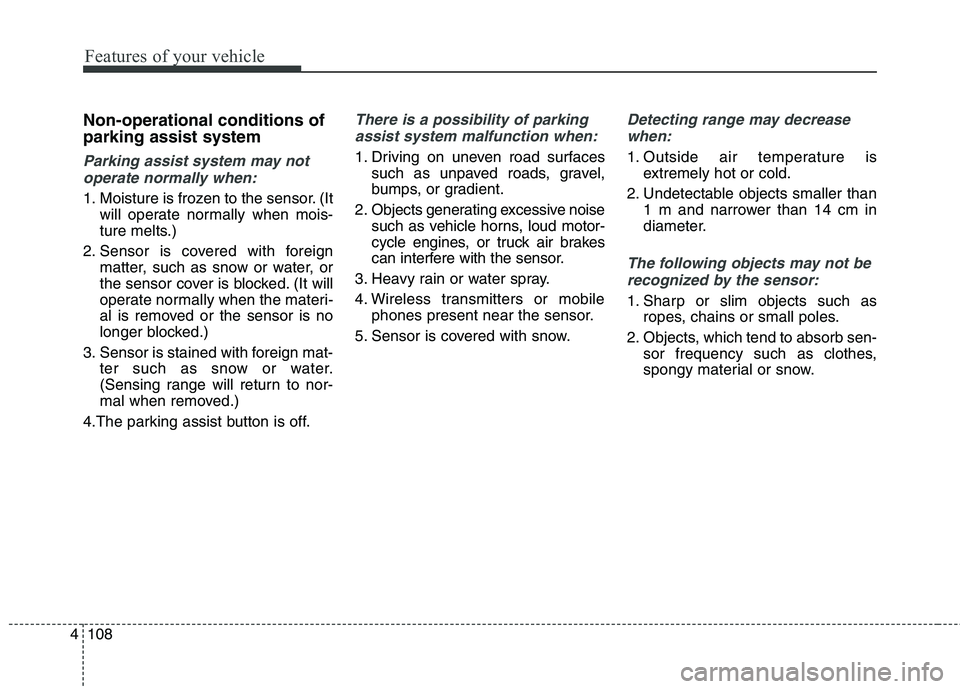
Features of your vehicle
108
4
Non-operational conditions of parking assist system
Parking assist system may not
operate normally when:
1. Moisture is frozen to the sensor. (It will operate normally when mois-
ture melts.)
2. Sensor is covered with foreign matter, such as snow or water, or
the sensor cover is blocked. (It will
operate normally when the materi-
al is removed or the sensor is no
longer blocked.)
3. Sensor is stained with foreign mat- ter such as snow or water.
(Sensing range will return to nor-
mal when removed.)
4.The parking assist button is off.
There is a possibility of parking assist system malfunction when:
1. Driving on uneven road surfaces such as unpaved roads, gravel,
bumps, or gradient.
2. Objects generating excessive noise such as vehicle horns, loud motor-
cycle engines, or truck air brakes
can interfere with the sensor.
3. Heavy rain or water spray.
4. Wireless transmitters or mobile phones present near the sensor.
5. Sensor is covered with snow.
Detecting range may decrease when:
1. Outside air temperature is extremely hot or cold.
2. Undetectable objects smaller than 1 m and narrower than 14 cm in
diameter.
The following objects may not be
recognized by the sensor:
1. Sharp or slim objects such as ropes, chains or small poles.
2. Objects, which tend to absorb sen- sor frequency such as clothes,
spongy material or snow.
Page 196 of 513
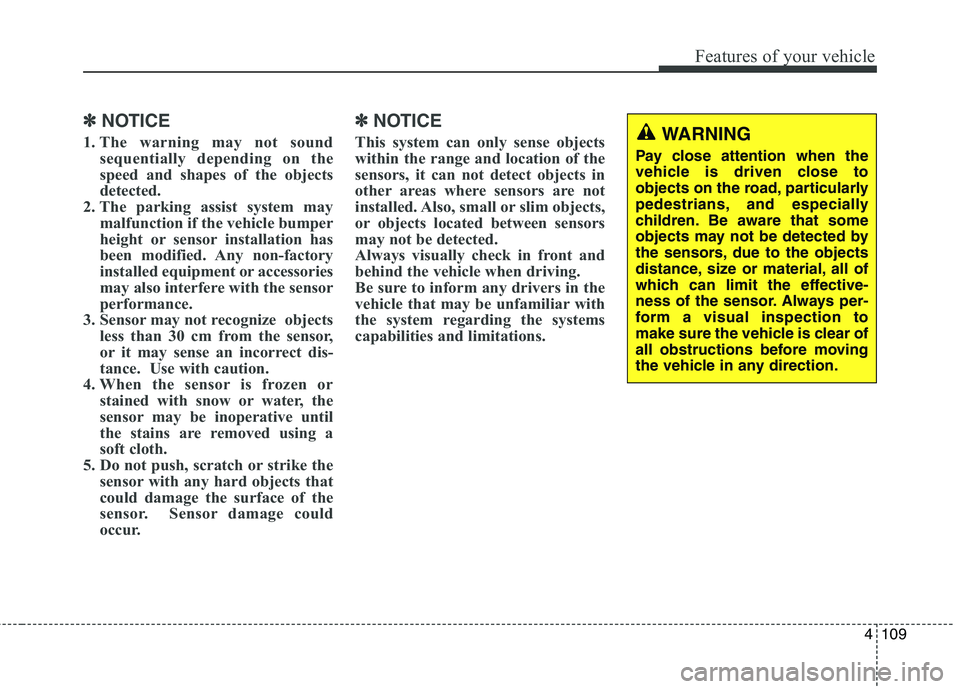
4109
Features of your vehicle
✽✽NOTICE
1. The warning may not sound sequentially depending on the
speed and shapes of the objects
detected.
2. The parking assist system may malfunction if the vehicle bumper
height or sensor installation has
been modified. Any non-factory
installed equipment or accessories
may also interfere with the sensor
performance.
3. Sensor may not recognize objects less than 30 cm from the sensor,
or it may sense an incorrect dis-
tance. Use with caution.
4. When the sensor is frozen or stained with snow or water, the
sensor may be inoperative until
the stains are removed using a
soft cloth.
5. Do not push, scratch or strike the sensor with any hard objects that
could damage the surface of the
sensor. Sensor damage could
occur. ✽✽
NOTICE
This system can only sense objects
within the range and location of the
sensors, it can not detect objects in
other areas where sensors are not
installed. Also, small or slim objects,
or objects located between sensors
may not be detected.
Always visually check in front and
behind the vehicle when driving.
Be sure to inform any drivers in the
vehicle that may be unfamiliar with
the system regarding the systems
capabilities and limitations.WARNING
Pay close attention when the
vehicle is driven close to
objects on the road, particularly
pedestrians, and especially
children. Be aware that some
objects may not be detected by
the sensors, due to the objects
distance, size or material, all of
which can limit the effective-
ness of the sensor. Always per-
form a visual inspection to
make sure the vehicle is clear of
all obstructions before moving
the vehicle in any direction.
Page 206 of 513

4119
Features of your vehicle
Auto light/AFLS position
When the light switch is in the AUTO light position, the taillights and head-
lights will be turned ON or OFF auto-matically depending on the amount
of light outside the vehicle.
If your vehicle is equipped with the
adaptive front lighting system
(AFLS), it will also operate when theheadlamp is ON.
AFLS (Adaptive Front LightingSystem) (if equipped)
Adaptive front lighting system uses
the steering angle and vehicle speed,
to keep your field of vision wide by
swiveling and leveling the headlamp.
Change the switch to the AUTO posi-
tion when the engine is running. The
adaptive front lighting system will
operate when the headlamp is ON.
To turn off the AFLS, change the
switch to other positions. After turn-
ing the AFLS off, headlamp swiveling
no longer occurs, but leveling oper-
ates continuously.
OKH042190
CAUTION
Never place anything over the sensor (1) located on theinstrument panel, this willensure better auto-light sys-tem control.
Don’t clean the sensor using a window cleaner, the cleanermay leave a light film whichcould interfere with sensoroperation.
If your vehicle has window tint or other types of coating onthe front windshield, the Autolight system may not workproperly.
OKH042187
Page 212 of 513
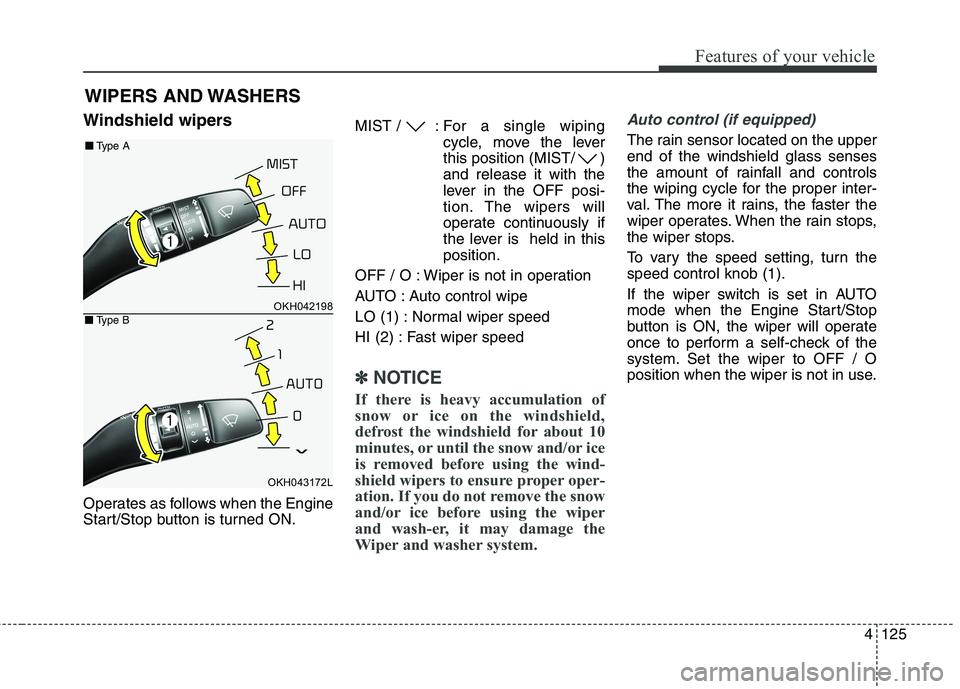
4125
Features of your vehicle
Windshield wipers
Operates as follows when the Engine
Start/Stop button is turned ON.MIST / : For a
single wiping
cycle, move the lever
this position (MIST/ )and release it with the
lever in the OFF posi-
tion. The wipers will
operate continuously if
the lever is held in thisposition.
OFF / O : Wiper is not in operation
AUTO : Auto control wipe
LO (1) : Normal wiper speed
HI (2) : Fast wiper speed
✽✽ NOTICE
If there is heavy accumulation of
snow or ice on the windshield,
defrost the windshield for about 10
minutes, or until the snow and/or ice
is removed before using the wind-
shield wipers to ensure proper oper-
ation. If you do not remove the snow
and/or ice before using the wiper
and wash-er, it may damage the
Wiper and washer system.
Auto control (if equipped)
The rain sensor located on the upper end of the windshield glass senses
the amount of rainfall and controls
the wiping cycle for the proper inter-
val. The more it rains, the faster the
wiper operates. When the rain stops,
the wiper stops.
To vary the speed setting, turn the speed control knob (1).
If the wiper switch is set in AUTO
mode when the Engine Start/Stop
button is ON, the wiper will operate
once to perform a self-check of the
system. Set the wiper to OFF / O
position when the wiper is not in use.
WIPERS AND WASHERS
OKH042198
OKH043172L
■■ Type A
■■Type B